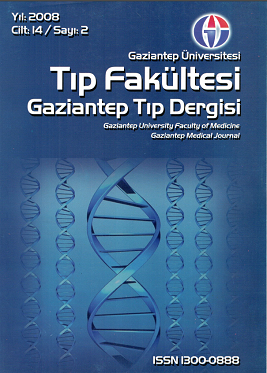Ureteroscopic Treatment Of Ureteral Calculi Our Results Of Multiaspect Evaluations In 1265 Patients
DOI:
https://doi.org/10.58600/eurjther.2008-14-2-1335-archKeywords:
Urinary stone, Ureter, Ureteroscopy, ESWLAbstract
In our study, the results of rigid ureteroscopy in the management of stones located in different segments of the ureter is being presented. Between 1995-2005, totally 1265 patients with ureteral stones (742 male, 523 female) with an avarage age value of 42.5 (ranged 18-74) years have been treated with rigid ureteroscopy. Depending on the size as well as their impaction to the ureteral wall, they were either directly removed by basket catheters or pneumatic lithotripsy has been used for disintegration of the stones. Success rates obtained with respect to stone location as well the irrigation fluid used and the operational time, auxiliary procedures and that of complication rates were comparatively evaluated. Stone size ranged from 0.4 to 2.3 cm (mean 1.4). While 459 (36.3%), stones were removed by ureteroscopy with basket application, pneumatic lithotripsy were necessary in 739 (58.4%) cases. Mean operation time was 25.4 (ranged from 9 to 39) minutes. In 1198 (94.7%) cases have been completely stone free after the procedure. In 67 cases (5.3%), the procedure was unsuccessful. Ureteral stent was applied in 243 cases following stone removal (19.2%). Our results have demonstrated that, ureteroscopy is a safe and effective manner in the treatment of ureteral stones. We believe that, this procedure should be the first treatment of choice in the management of the stones located especially in the lower part of the ureter when compared with ESWL (Extracorporeal Shock Wave Lithotripsy). Additionaly, this procedure can also be applied in mid and upper ureteral stones in skilled hands with enough experience.
Metrics
References
Drach GW. Urinary Lithiasis:Etiology, Diagnosis and Medical Management. In:Walsh PC, Retik AB, Stamey TA, Vaughan ED,eds. Campbell's Urology.Philadelphia. 1992:2085-2156.
Stoller M, Bolton D, Urinary stone disease. In Tanagho EA, McAninch JW, eds. Smith's General Urology. Singapore. 1995:276-306.
Chaussy C, Schmiedt E, Jocham D, Brendel W, Forssmann B, Walther V. First clinical experience with extracorporeally induced destruction of kidney stones by shock waves. J Urol. 1982;127(3):417-20.
Segura JW, Preminger GM, Assimos DG, Dretler SP, Kahn RI, Lingeman JE, et al. Ureteral Stones Clinical Guidelines Panel summary report on the management of ureteral calculi. The American Urological Association. J Urol. 1997;158(5):1915-21.
Yamaguchi K, Minei S, Yamazaki T, Kaya H, Okada K.Characterization of ureteral lesions associated with impacted stones.Int J Urol. 1999;6(6):281-5.
Willis LR, Evan AP, Connors BA, Blomgren P, Fineberg NS, Lingeman JE. Relationship between kidney size, renal injury, and renal impairment induced by shock wave lithotripsy. J Am Soc Nephrol. 1999;10(8):1753-62.
Willis LR, Evan AP, Connors BA, Shao Y, Blomgren PM, Pratt JH, et al. Shockwave lithotripsy: dose-related effects on renal structure, hemodynamics, and tubular function. J Endourol. 2005;19(1):90-101.
Bagley DH. Indications for Ureteropyeloscopy. In: Huffman JL, Bagley DH, Lyon ES, eds. Ureteroscopy. Philadelphia. 1988:17-30.
B Bierkens AF, Hendrikx AJ, De La Rosette JJ, Stultiens GN, Beerlage HP, Arends AJ, et al. Treatment of mid- and lower ureteric calculi: extracorporeal shock-wave lithotripsy vs laser ureteroscopy. A comparison of costs, morbidity and effectiveness. Br J Urol. 1998;81(1):31-5.
Küpeli B, Alkibay T, Sinik Z, Karaoğlan U, Bozkirli I.What is the optimal treatment for lower ureteral stones larger than 1 cm? Int J Urol. 2000;7(5):167-71.
Margalith I, Shapiro A. Anxiety and Patient participation in clinical decision-making:the case of patients with ureteral calculi. Soc Sci Med. 1997;45:419-427.
Hendrikx AJ, Strijbos WE, de Knijff DW, Stultiens GN, Beerlage HP, Arends AJ, et al. Treatment for extended-mid and distal ureteral stones: SWL or ureteroscopy? Results of a multicenter study. J Endourol. 1999;13:727-733.
Biri H, Küpeli B, Isen K, Sinik Z, Karaoğlan U, Bozkirli I.Treatment of lower ureteral stones: extracorporeal shockwave lithotripsy or intracorporeal lithotripsy? J Endourol. 1999;13(2):77-81.
Bierkens Af, Hendrikx AJM, De La Rosette JJMCH, Stultiens GN, Beerlage HP, Arends AJ, et al. Treatment of mid-and lower ureteric calculi: extracorporeal shock-wave lithotripsy vs laser ureteroscopy. A comparison of costs, morbidity and effectiveness. Br J Urol. 1998;81:31-35.
Kupeli B, Biri H, Isen K, Onaran M, Alkibay T, Karaoğlan U, Bozkirli I. Treatment of ureteral stones: comparison of extracorporeal shock wave lithotripsy and endourologic alternatives. Eur Urol. 1998;34:474-479.
Rızvı SAH, Naqvı SAA, Hussaın Z, Hashmı A, Hussaın M, Zafar MN, et al. The management of stone disease. BJU Int. 2002;89:62-68.
Tawfiek E, Bagley HD. Management of upper urinary tract calculi with ureteroscopic techniques. Urology. 1999;53(1):25- 31.
Jeongy H, Kwak C, Hong S, Lee S. Ureteral Stentind After Ureteroscopy for Ureter Stones: Prospective Randomısed Study Assesing Symtoms and Complications. Eur Urol. 2003;2:32-36.
Giacomelli G, Nozzo RE, Manzo M, Gastaldi L, Moroni M. Ureteral stending following ureteroscopy for ureteral lıthiasis: İs it really necessary? Eur Urol. 2004;3(6):138-144. 20. Whıtfıeld H N. The management of ureteric stones. Part II: Therapy. BJU Int. 1999;84:916-921.
Downloads
Published
How to Cite
Issue
Section
License
Copyright (c) 2023 European Journal of Therapeutics

This work is licensed under a Creative Commons Attribution-NonCommercial 4.0 International License.
The content of this journal is licensed under a Creative Commons Attribution-NonCommercial 4.0 International License.


















